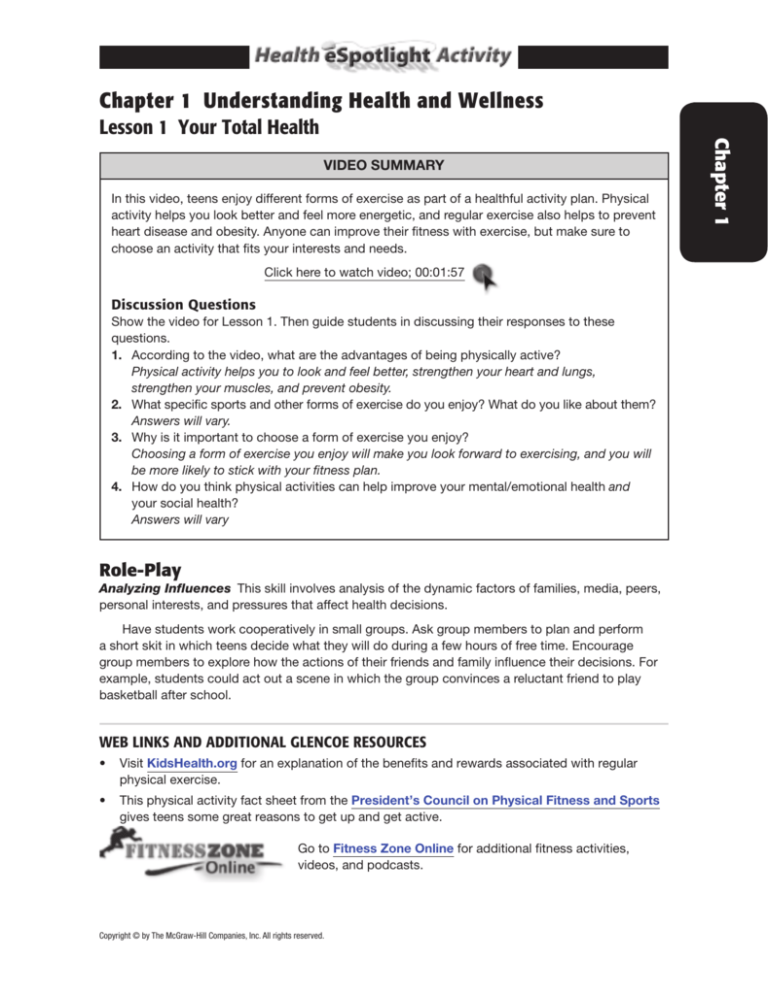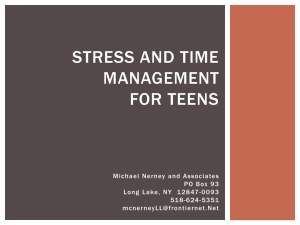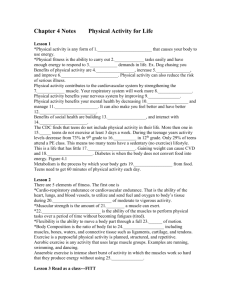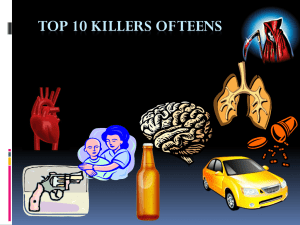
Chapter 1 Understanding Health and Wellness
VIDEO SUMMARY
In this video, teens enjoy different forms of exercise as part of a healthful activity plan. Physical
activity helps you look better and feel more energetic, and regular exercise also helps to prevent
heart disease and obesity. Anyone can improve their fitness with exercise, but make sure to
choose an activity that fits your interests and needs.
Click here to watch video; 00:01:57
Discussion Questions
Show the video for Lesson 1. Then guide students in discussing their responses to these
questions.
1. According to the video, what are the advantages of being physically active?
Physical activity helps you to look and feel better, strengthen your heart and lungs,
strengthen your muscles, and prevent obesity.
2. What specific sports and other forms of exercise do you enjoy? What do you like about them?
Answers will vary.
3. Why is it important to choose a form of exercise you enjoy?
Choosing a form of exercise you enjoy will make you look forward to exercising, and you will
be more likely to stick with your fitness plan.
4. How do you think physical activities can help improve your mental/emotional health and
your social health?
Answers will vary
Role-Play
Analyzing Influences This skill involves analysis of the dynamic factors of families, media, peers,
personal interests, and pressures that affect health decisions.
Have students work cooperatively in small groups. Ask group members to plan and perform
a short skit in which teens decide what they will do during a few hours of free time. Encourage
group members to explore how the actions of their friends and family influence their decisions. For
example, students could act out a scene in which the group convinces a reluctant friend to play
basketball after school.
WEB LINKS AND ADDITIONAL GLENCOE RESOURCES
•
Visit KidsHealth.org for an explanation of the benefits and rewards associated with regular
physical exercise.
•
This physical activity fact sheet from the President’s Council on Physical Fitness and Sports
gives teens some great reasons to get up and get active.
Go to Fitness Zone Online for additional fitness activities,
videos, and podcasts.
Copyright © by The McGraw-Hill Companies, Inc. All rights reserved.
Chapter 1
Lesson 1 Your Total Health
Name _________________________________________ Date _______________ Class ____________
Chapter 1 Understanding Health and Wellness
VIDEO SUMMARY
In this video, teens enjoy different forms of exercise as part of a healthful activity plan.
Physical activity helps you look better and feel more energetic, and regular exercise
also helps to prevent heart disease and obesity. Anyone can improve their fitness
with exercise, but make sure to choose an activity that fits your interests and needs.
After you have watched the video, write your responses to these questions.
1.
According to the video, what are the advantages of being physically active?
2.
What specific sports and other forms of exercise do you enjoy? What do you like
about them?
3.
Why is it important to choose a form of exercise you enjoy?
4.
How do you think physical activities can help improve your mental/emotional health
and your social health?
Copyright © by The McGraw-Hill Companies, Inc. All rights reserved.
Chapter 1
Lesson 1 Your Total Health
Chapter 1 Understanding Health and Wellness
VIDEO SUMMARY
This video shows a high school that has made healthy changes to the cafeteria menu. A food
service manager explains that the cafeteria has replaced junk food in the vending machines
with healthier options such as baked chips, fruit, and vegetables. Many students welcome the
change as a tool for improving their lifestyle.
Click here to watch video; 00:01:44
Discussion Questions
Show the video for Lesson 2. Then guide students in discussing their responses to these
questions.
1. Students at the high school in the video can still get fries at the snack bar. Do you think the
school should offer that option? Why or why not?
Answers will vary.
2. The high school in the video replaced junk food items in the vending machines with healthier
options. How does your school promote healthful eating? What other healthful changes
would you suggest?
Answers will vary.
3. What junk foods do you enjoy? What more healthful foods could you substitute for those
junk foods?
Answers will vary.
4. How do the people around you influence your food choices? For example, do you eat the
same kinds of food when you are at home with your family or out with your friends?
Answers will vary.
Create
Advocacy This skill calls for the use of persuasion to promote positive health choices personally
and for others.
Have students work with partners to plan and make posters encouraging teens to make
healthful food choices. Ask students to plan simple posters with clear messages, focusing for
example on a single reason for choosing healthful food or a single substitute for a less-healthful
food. If possible, display the completed posters in your school’s lunchroom or hallways.
WEB LINKS AND ADDITIONAL GLENCOE RESOURCES
•
The Healthy Meals Resource System is a USDA-sponsored Web site that provides links to studies,
articles, and ideas for implementing healthier school lunches.
•
The Food Project is a movement in which teens help to produce healthy food for city and
suburb residents. Click on the link to learn how teens are working together to promote a
sustainable, local food system.
Go to Fitness Zone Online for additional fitness activities,
videos, and podcasts.
Copyright © by The McGraw-Hill Companies, Inc. All rights reserved.
Chapter 1
Lesson 2 What Affects Your Health?
Name _________________________________________ Date _______________ Class ____________
Chapter 1 Understanding Health and Wellness
VIDEO SUMMARY
This video shows a high school that has made healthful changes to the cafeteria
menu. A food service manager explains that the cafeteria has replaced junk food
in the vending machines with healthier options such as baked chips, fruit, and
vegetables. Many students welcome the change as a tool for improving their lifestyle.
After you have watched the video, write your responses to these questions.
1.
Students at the high school in the video can still get fries at the snack bar. Do you
think the school should offer that option? Why or why not?
2.
The high school in the video replaced junk food items in the vending machines
with healthier options. How does your school promote healthful eating? What other
healthful changes would you suggest?
3.
What junk foods do you enjoy? What more healthful foods could you substitute for
those junk foods?
4.
How do the people around you influence your food choices? For example, do
you eat the same kinds of food when you are at home with your family or out with
your friends?
Copyright © by The McGraw-Hill Companies, Inc. All rights reserved.
Chapter 1
Lesson 2 What Affects Your Health?
Chapter 1 Understanding Health and Wellness
VIDEO SUMMARY
In this video, you learned that many teens are chronically sleep deprived. Because their body
clocks have shifted with puberty, most teens have difficulty going to sleep early enough to get
the recommended nine hours of sleep. Also, many teens’ busy schedules leave little time for a
healthy amount of sleep. Tips for improving sleep include keeping TVs and computers out of the
bedroom, avoiding caffeine after lunch, and following a regular sleeping and waking schedule.
Click here to watch video; 00:03:30
Discussion Questions
Show the video for Lesson 3. Then guide students in discussing their responses to these
questions.
1. Why is it hard for many teens to get up and be alert in the morning?
Teens are naturally inclined to stay up later, and their busy schedules do not allow for
adequate sleep.
2. What is the recommended number of hours of sleep for teens? How many hours do you
usually sleep each night?
Experts recommend that teens get 8-9 hours of sleep per night. Answers will vary.
3. What health risks are associated with sleep deprivation? Consider risks to physical health,
mental/emotional health, and social health.
Health risks include exhaustion, moodiness, depression, and difficulty concentrating.
4. What do you consider to be the best advice for teens who should get more sleep?
Answers will vary.
Discuss
Communication This skill is an interactive process between and among individuals to clarify
ideas, thoughts, needs, and feelings.
Divide students into groups of four or five. Ask group members to consider two high school
schedules: early morning start and early afternoon dismissal; late morning start and late afternoon
dismissal. Have them brainstorm a list of the advantages of each schedule and then discuss which
schedule would be best for teens.
WEB LINKS AND ADDITIONAL GLENCOE RESOURCES
•
This chart on the National Public Radio Web site compares the caffeine content of some
common energy drinks, sodas, and other beverages. Find out which drinks are the worst caffeine
offenders and calculate how much caffeine you consume in a day.
•
In this article on the National Public Radio Web site, doctors discuss the many reasons for teen
sleep deprivation.
Go to Fitness Zone Online for additional fitness activities,
videos, and podcasts.
Copyright © by The McGraw-Hill Companies, Inc. All rights reserved.
Chapter 1
Lesson 3 Health Risks and Your Behavior
Name _________________________________________ Date _______________ Class ____________
Chapter 1 Understanding Health and Wellness
VIDEO SUMMARY
In this video, you learned that many teens are chronically sleep deprived. Because
their body clocks have shifted with puberty, most teens have difficulty going to sleep
early enough to get the recommended nine hours of sleep. Also, many teens’ busy
schedules leave little time for a healthy amount of sleep. Tips for improving sleep
include keeping TVs and computers out of the bedroom, avoiding caffeine after
lunch, and following a regular sleeping and waking schedule.
After you have watched the video, write your responses to these questions.
1.
Why is it hard for many teens to get up and be alert in the morning?
2.
What is the recommended number of hours of sleep for teens? How many hours do
you usually sleep each night?
3.
What health risks are associated with sleep deprivation? Consider risks to physical
health, mental/emotional health, and social health.
4.
What do you consider to be the best advice for teens who should get more sleep?
Copyright © by The McGraw-Hill Companies, Inc. All rights reserved.
Chapter 1
Lesson 3 Health Risks and Your Behavior
Chapter 1 Understanding Health and Wellness
VIDEO SUMMARY
This video focuses on a current trend called the “slow food movement” and how it is being
considered by elementary schools as a means of improving the health and eating habits
of young students. A culinary school graduate, who introduced the program at the school,
explains that the slow food movement helps people understand where food comes from and
how it should be enjoyed. Children learn how food is grown, and then they work together to
prepare a meal and sit down to enjoy it together.
Click here to watch video; 00:01:09
Discussion Questions
Show the video for Lesson 4. Then guide students in discussing their responses to these
questions.
1. What is the purpose of the slow food movement?
The slow food movement discourages junk food consumption by teaching children where
food comes from, how to prepare it, and how to enjoy it.
2. How are the slow food activities at the school affecting the students’ physical health, mental/
emotional health, and social health?
Students gather together to eat and prepare healthy food as a team, so they have the
opportunity to build relationships as they improve their physical health.
3. How do you think the slow food movement can help children—and teens and adults—avoid
obesity?
If children, teens, and adults learn to prepare healthy, delicious food from fresh ingredients,
they will be less likely to eat convenience foods and junk foods.
Explore
Practicing Healthful Behaviors This skill is the actual practice of healthful behavior. It includes
the steps and procedures used to promote wellness.
Have each student find (or create) a recipe for a “slow food.” The dish does not need to cook
for a long time, or even be cooked at all. It should, however, be based on fresh, non-processed
ingredients. Ask students to share their recipes with the rest of the class. Encourage interested
students to prepare their recipes for a class tasting of slow foods.
WEB LINKS AND ADDITIONAL GLENCOE RESOURCES
•
Visit the Academy for Educational Development to find out how teens are promoting health
literacy in their schools and communities.
•
Learn more about the slow food movement at slowfoodusa.org. Find local slow food chapters, or
get information about starting a slow food chapter in your community.
Go to Fitness Zone Online for additional fitness activities,
videos, and podcasts.
Copyright © by The McGraw-Hill Companies, Inc. All rights reserved.
Chapter 1
Lesson 4 Promoting Health and Wellness
Name _________________________________________ Date _______________ Class ____________
Chapter 1 Understanding Health and Wellness
VIDEO SUMMARY
This video focuses on a current trend called the “slow food movement” and how
it is being considered by elementary schools as a means of improving the health
and eating habits of young students. A culinary school graduate, who introduced
the program at the school, explains that the slow food movement helps people
understand where food comes from and how it should be enjoyed. Children learn
how food is grown, and then they work together to prepare a meal and sit down to
enjoy it together.
After you have watched the video, write your responses to these questions.
1.
What is the purpose of the slow food movement?
2.
How are the slow food activities at the school affecting the students’ physical health,
mental/emotional health, and social health?
3.
How do you think the slow food movement can help children—and teens and
adults—avoid obesity?
Copyright © by The McGraw-Hill Companies, Inc. All rights reserved.
Chapter 1
Lesson 4 Promoting Health and Wellness






